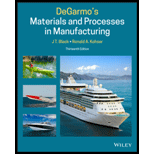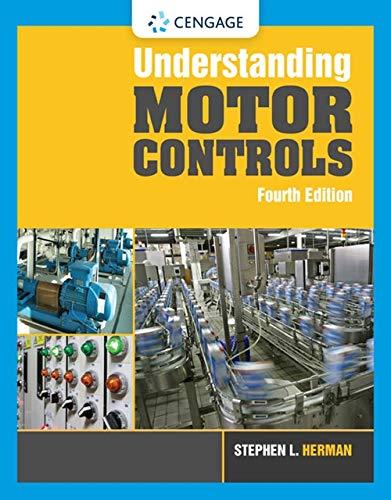
Degarmo's Materials And Processes In Manufacturing
13th Edition
ISBN: 9781119492825
Author: Black, J. Temple, Kohser, Ronald A., Author.
Publisher: Wiley,
expand_more
expand_more
format_list_bulleted
Concept explainers
Question
Chapter 3, Problem 13RQ
To determine
The location of the bonding electrons in a metallic bonded material.
Expert Solution & Answer
Want to see the full answer?
Check out a sample textbook solution
Students have asked these similar questions
Which type of bonding between atoms is characterized by the sharing of electrons between two or more atoms?
Covalent
Ionic
Metallic
Van Der Waals
Please answer the question in the image (explantion not needed)
What are valid reasons for adding Yttrium to the zirconia in the Thermal Barrier Coating (TBC) in a turbine blade?
Select one or more:
a.
To match the thermal conductivity of the TBC to the metal substrate
b.
To increase the weight of the TBC
c.
To prevent a change of the crystallographic structure as the temperature changes
d.
To match the thermal conductivity of the TBC to the underlying oxide layer
e.
To avoid breakage during change in thermal conditions
What type of bonding would be expected for each of these materials.
(1).Brass
(2). Rubber
(3).Aluminum sulphide
(4).NaCl
Chapter 3 Solutions
Degarmo's Materials And Processes In Manufacturing
Ch. 3 - What enables us to control the properties and...Ch. 3 - Â What are the next levels of structure that are...Ch. 3 - Prob. 3RQCh. 3 - Prob. 4RQCh. 3 - Prob. 5RQCh. 3 - Prob. 6RQCh. 3 - What are the three types of primary bonds, and...Ch. 3 - What are some general characteristics of...Ch. 3 - Prob. 9RQCh. 3 - Prob. 10RQ
Ch. 3 - Prob. 11RQCh. 3 - Prob. 12RQCh. 3 - Prob. 13RQCh. 3 - What are some unique property features of...Ch. 3 - Prob. 15RQCh. 3 - Prob. 16RQCh. 3 - Prob. 17RQCh. 3 - What are some of the general characteristics of...Ch. 3 - Prob. 19RQCh. 3 - Prob. 20RQCh. 3 - Prob. 21RQCh. 3 - Prob. 22RQCh. 3 - Prob. 23RQCh. 3 - Prob. 24RQCh. 3 - What is a grain? A grain boundary?Ch. 3 - Prob. 26RQCh. 3 - What is implied by a low ASTM grain�size number?...Ch. 3 - Prob. 28RQCh. 3 - What is Poissons ratio, and under what conditions...Ch. 3 - What is plastic deformation?Ch. 3 - Why do metals retain their strength during plastic...Ch. 3 - Prob. 32RQCh. 3 - Prob. 33RQCh. 3 - What is a dislocation? Using the carpet analogy,...Ch. 3 - What is the difference between an edge dislocation...Ch. 3 - What are some of the common barriers to...Ch. 3 - Prob. 37RQCh. 3 - What is the mechanism (or mechanisms) responsible...Ch. 3 - Why is a fine grain size often desired in an...Ch. 3 - What is an anisotropic property? Why might...Ch. 3 - What is the difference between brittle fracture...Ch. 3 - How does a metal increase its internal energy...Ch. 3 - What is required in order to drive the...Ch. 3 - How might the lowest recrystallization temperature...Ch. 3 - In what ways can recrystallization be used to...Ch. 3 - What is the major distinguishing feature between...Ch. 3 - What is warm working?Ch. 3 - How can deformation and recrystallization improve...Ch. 3 - Why is grain growth usually undesirable?Ch. 3 - Prob. 50RQCh. 3 - As a result of their ionic or covalent bonding,...Ch. 3 - Prob. 52RQCh. 3 - Prob. 53RQCh. 3 - What is the difference between an intrinsic...Ch. 3 - What is required for electrical conductivity in...Ch. 3 - What is required for electrical conductivity in...Ch. 3 - Brass is an alloy of copper with a certain amount...Ch. 3 - It is not uncommon for processing operations to...Ch. 3 - Polyethylene consists of fibrous molecules of...Ch. 3 - Prob. 5P
Knowledge Booster
Learn more about
Need a deep-dive on the concept behind this application? Look no further. Learn more about this topic, mechanical-engineering and related others by exploring similar questions and additional content below.Similar questions
- The plot below shows bonding energy vs. interatomic separation for two elements. АВ a A. Which element would you expect to have a lower melting point? A B same can't tell provide a brief justification of your choice. B. Which element would you expect to have a smaller lattice constant? A В same can't tell provide a brief justification of your choice. C. Which element would you expect to have a larger elastic modulus? A justification of your choice. В same can't tell provide a brief can't tell provide a brief D. Which element would you expect to have the highest yield stress? justification of your choice. A В same Bonding energyarrow_forwardChoose the correct examples of hexagonal closed packing structure in the following options. O Manganese and Magnesium O inc and Manganese O Beryllium and Zinc O Magnesium and Ironarrow_forwarde-Services Acader Courses Reports Learning Portal False When electrons are in conduction band, they conduct electricity. Select one: O True O False Identify the correct example for Face Centered Cubic structure fre Select one: O Molybdenum O Berilium O Copper O Poloniumarrow_forward
- Which of the following are true regarding crystalline and non-crystalline materials at the atomic scale? Select one or more: a. Crystalline materials show no long-range order b. There are an infinite number of crystal systems and lattices possible C. Density of packing is higher for crystalline materials d. Bond energy is lower for noncrystalline materials Materials which are not crystalline are referred to as amorphous Bond length is shorter for crystalline versus noncrystalline materials e.arrow_forwardIn the electron arrangement of a calcium atom, how many electrons are in the second energy level? Plz solvearrow_forwardIncreasing the temperature of a semiconductor breaks covalent bonds. For each broken bond, two electrons become free to move and transfer electrical charge. What fraction of the total valance electrons are free to move and what fraction of the covalent bonds must be broken in order that 5×1015 electrons conduct electrical charge in 50 g of silicon?arrow_forward
- A metal has a radius of 0.137 nm, and a planar density of 9.4185462889145 nm-2 in the (110) plane. What is the crystal structure of the material? a. BCC with atomic radius 0.137 nm b. HCP with atomic radius 0.137 nm O c. FCC with atomic radius 0.137 nm O d. Something else; atomic radius 0.137 nmarrow_forwardBriefly state how the weak bonds form and explain their effects on the mechanical properties of materials.arrow_forwardBriefly describe the following types of primary bonding: (a) ionic, (b) covalent, and (c) metallic. A solder contains 52 wt % tin and 48 wt % lead. What are the atomic percentages of Sn and Pb in the solder? A hydrogen atom exists with its electron in the n = 4 state. The electron undergoes a transition to the n=3 state. Calculate (i) the energy of the photon emitted, (ii) its frequency, and (iii) its wavelength in nanometers (nm).arrow_forward
- 1- The electrical conductivity of metal are good in comparing with another type of materials? *arrow_forwardEngineering science Distinguish elastic, electrical and magnetic hysteresis in different Materials.arrow_forwardA half a plane of atoms are inserted into the crystal lattice is known as_ O Screw Dislocation O Edge Dislocation O Surface Imperfections O Grain Boundary Imperfectionsarrow_forward
arrow_back_ios
SEE MORE QUESTIONS
arrow_forward_ios
Recommended textbooks for you
 Understanding Motor ControlsMechanical EngineeringISBN:9781337798686Author:Stephen L. HermanPublisher:Delmar Cengage Learning
Understanding Motor ControlsMechanical EngineeringISBN:9781337798686Author:Stephen L. HermanPublisher:Delmar Cengage Learning

Understanding Motor Controls
Mechanical Engineering
ISBN:9781337798686
Author:Stephen L. Herman
Publisher:Delmar Cengage Learning
Dislocations and Plastic Deformation; Author: LearnChemE;https://www.youtube.com/watch?v=cpvTwYAUeA8;License: Standard Youtube License